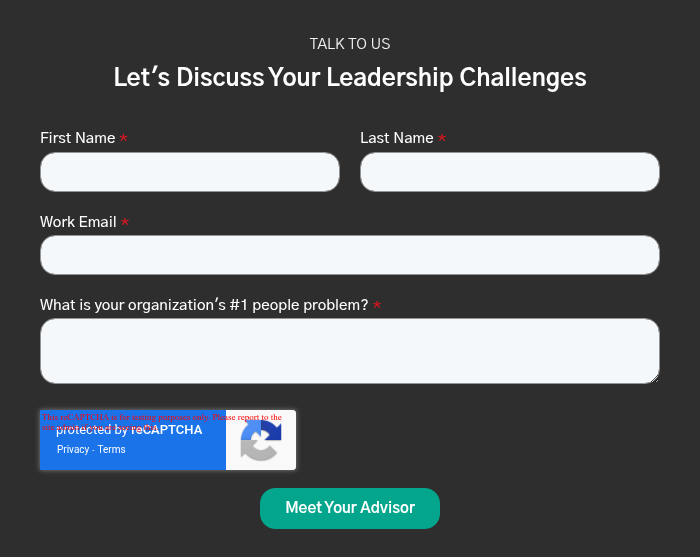
Organizations often assume any well-regarded leadership training program will suffice for training leaders. The thinking follows a standard logic: leadership is a skill, so any structured development should yield results. However, this assumption overlooks the individual variables that influence how a leader internalizes and applies new learning.
In practice, leadership training is not a plug-and-play solution. Leaders vary in how they learn, how much time they can commit, the formats they prefer, and the environments in which they thrive. Some benefit from intense, short-term coaching. Others need the structure of long-term programs. Many must weigh cost, travel, and schedule flexibility. When these considerations are mismatched, even excellent programs can yield minimal results.
Just ask Tiffany, a newly promoted HR Director who enrolled in Harvard's Executive program, a well-known, expensive leadership bootcamp. Everyone told her it was “the best.” But two weeks in, she was overwhelmed. The pace was too fast, the case studies too theoretical. She left sessions more frustrated than inspired. Six months later, she joined a peer coaching group instead. It had accountability, space to reflect, and real application. The difference? Night and day. “I stopped performing and started learning,” she said. The lesson: it’s not about the program’s prestige. It’s about the fit.
The challenge is not finding a leadership program. The challenge is finding the right program for the right leader at the right time. Without this fit, organizations risk wasted resources, disengaged participants, and underwhelming outcomes. Leaders must evaluate both their learning needs and practical constraints to select a development pathway that aligns with their goals and context.
In this article, you will learn:
- The Importance of Aligning Leadership Training with Learning Styles
- How Preferred Learning Formats Influence Leadership Development Success
- Choosing the Right Leadership Program Based on Budget and Duration
- Best Situations to Use Coaching, Peer Groups, or Classroom Training
- Why Sticky Learning Is Key to Sustainable Leadership Growth

The Importance of Aligning Leadership Training with Learning Styles
Effective leadership development starts with self-awareness, not curriculum. Leaders must understand how they best absorb and apply new knowledge. Some prefer structured reading and theory. Others retain more from experiential formats such as workshops, simulations, or case studies. For others, learning happens best through continuous exposure like listening to leadership podcasts, watching short-form videos, or engaging in peer discussions.
Programs that align with a leader’s natural learning preference tend to yield greater retention and practical application. Leaders who favor solitary reflection may benefit more from executive coaching or asynchronous content. Those who thrive in interactive settings might prefer classroom-style training or cohort-based leadership development classes. The delivery method matters as much as the content itself.

How Preferred Learning Formats Influence Leadership Development Success
Virtual learning continues to expand access to high-quality leadership training, but it is not ideal for every leader. Some struggle to engage meaningfully through a screen. Others thrive in virtual formats because they eliminate travel time and provide more flexible pacing. Choosing between in-person and virtual delivery should depend on more than logistics. It requires an honest evaluation of where a leader feels most comfortable and effective.
In-person sessions foster immediacy and connection, which can enhance psychological safety and engagement. Virtual learning offers scalability and convenience, especially for distributed teams. Hybrid models, which blend live sessions with asynchronous content, increasingly offer a balanced solution. Leaders should weigh comfort level, travel feasibility, and organizational norms when deciding which format will work best.

Choosing the Right Leadership Program Based on Budget and Duration
Leadership training programs vary significantly in cost. At one end are free resources such as articles, podcasts, and online seminars. At the other are highly specialized executive leadership coaching programs or multi-year MBA degrees that can cost hundreds of thousands of dollars. Cost alone does not determine value, but leaders must be realistic about their budget constraints.
Duration is equally critical. Some leaders may benefit from a one-day intensive focused on a specific skill. Others require sustained engagements that allow for iteration, feedback, and long-term behavior change. Options range from one-off workshops to semester-long leadership development classes or multi-month coaching programs. Time commitment must match the leader’s availability and the complexity of the outcomes desired.

Best Situations to Use Coaching, Peer Groups, or Classroom Training
The structure of a leadership development program influences both the depth and scope of learning. One-on-one coaching provides customized support, ideal for addressing specific behavioral patterns or leadership blind spots. It offers a confidential environment where leaders can explore challenges in depth.
Cohort-based learning brings leaders together to share experiences and gain perspective. Peer learning can be particularly effective when developing strategic leadership capabilities, as it encourages cross-functional insights and network-building. Classroom settings, whether in-person or virtual, introduce structured content in a shared context. They are useful for establishing baseline competencies across a leadership team and creating a supportive forum among peers for early implementation.
Each of these structures has value. The choice depends on the leader’s development goals, interpersonal comfort level, and the type of support they find most helpful. Some programs, such as those within The Metiss Group’s The Leadership Academy™, offer a combination of these formats, allowing for layered development and peer accountability.

Why Sticky Learning Is Key to Sustainable Leadership Growth
Leadership growth is not defined by what happens during a single workshop. It is determined by what happens after the workshop is complete. Sticky learning refers to development that endures, it’s the behavioral change that takes hold because it is reinforced over time through feedback, application, and repetition.
The 70/20/10 model provides a useful framework. In this approach, only 10 percent of leadership growth comes from structured learning, such as classroom instruction or reading. Another 20 percent is derived from coaching and feedback. The remaining 70 percent comes from real-time application of new skills on the job. This model underscores why sustainable leadership development must go beyond isolated training events.
Programs that support sticky learning do more than transfer knowledge. They create conditions for continuous reflection, structured accountability, and peer or coach reinforcement. Leaders not only learn, they practice. They adjust. They revisit ideas as challenges evolve. The result is leadership behavior that becomes embedded and not forgotten.

Takeaways
Selecting a leadership development program is not a checklist exercise. It requires leaders to reflect on how they learn, how they work, and what type of structure will lead to sustainable improvement. One-on-one coaching, peer cohorts, and classroom sessions each offer different advantages. The right format depends on the leader’s goals, style, and schedule.
Equally important is ensuring the learning sticks. Leadership development must extend beyond theory. It must be applied, tested, and refined in real business contexts. Programs grounded in the 70/20/10 model are more likely to produce lasting change because they engage leaders where it matters most: in the daily execution of their responsibilities.
When organizations invest in development that aligns with both the individual and the strategy, leadership becomes more than a role. It becomes a practiced discipline that shapes culture, drives results, and builds long-term capacity.

Topics: